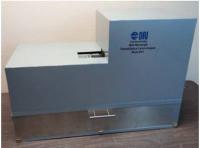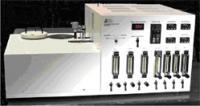2016 新產品:DRI2015 OCEC 多波段氣膠碳成份分析儀

DRI Model 2015
Multi-Wavelength Thermal/Optical Carbon Analyzer
Magee Scientific, Production of DRI Model 2015
Overview
The DRI Model 2015 Multi-Wavelength Thermal/Optical Carbon Analyzer enhances the widely-used DRI Model 2001 system for quantifying organic carbon (OC), elemental carbon (EC, also termed Black Carbon [BC]), and temperature-separated carbon fractions on aerosol filter deposits. The Model 2015 retains OC and EC consistency with previous measurements while reducing costs of supplies and maintenance compared with the Model 2001. It replaces the 633 nm optical monitoring that accounts for OC charring with reflected (R) and transmitted (T) intensities at wavelengths of 405, 445, 532, 635, 780, 808, and 980 nm. The additional optical information can be used to estimate multi-wavelength light absorption of the sampled particles, quantify the concentration of brown carbon (BrC) in each sample, and further complement the use of carbon fractions in source apportionment studies.
Model 2015 software includes temperature programs for commonly-used protocols such as IMPROVE_A, EUSAAR, and NIOSH, and it can be programmed to emulate any other protocol. The simultaneous measurement of both R and T at all wavelengths throughout each analysis allows for reproducing any other thermal/optical method and holds potential for better characterizing additional properties of the carbonaceous aerosol.
有機碳/元素碳分析儀 (DRI-2001A OC/EC Analyzer)_已經停產
The Model 2001 is the much refined, commercialized version of the OC/EC analyzer used at Desert Research Institute for the U.S. EPA’s visibility assessment program “Interagency Monitoring of Protected Visual Environments (IMPROVE)”. It was developed with key features to facilitate particulate carbon research as well as analytical production. Some of the features like dual modes of pyrolysis monitoring, automatic boat inlet, and MS ACCESS, do increase the cost of the analyzer. But the resulting product is unmatched by other analyzers. An automatic sample loader, due to be released in late 2007 will work in conjunction with the automatic boat inlet to process up to 18 samples sequentially unattended. The analyzer designated as Model 2001A can be fitted with the automated sample loader at any time subsequent to the initial purchase.
有機碳/元素碳分析儀 (Thermal Optical Carbon Analyzer, DRI Model 2001A)是以電腦操控分析氣膠成份儀器,應用於分析收集在濾紙上微粒樣品中的有機碳和元素碳(OC/EC)含量。 原理: 氣膠樣品中的有機碳和元素碳含量由IMPROVE(Interagency Monitoring of Protected Visual Environment)分析協議規定的加熱光學反射法(TOR)獲得。該方法的主要測試原理是:在無氧的純氦氣環境中逐步(溫度梯度)加熱,將 0.530 cm2的濾紙上的微粒態碳轉化為 二氧化碳(CO2);然後再將樣品在含2%氧氣的氦氣環境下逐步(溫度梯度)加熱,此時樣品中的元素碳釋放出來。上述各個溫度梯度下產生的CO2,經氧化爐(MnO2)催化,於還原環境下轉化為可通過火焰離子化檢測器(FID)檢測的甲烷(CH4) 。 樣品在加熱過程中, 部分有機碳可發生裂解現象而形成黑碳,使濾膜變黑,導致圖譜上的有機碳和元素碳峰不易區分。因此,在測量過程中,採用 633 nm的氦-氖激光監測濾紙的反射光強度變化,明確指示出元素碳氧化的起始點。有機碳裂解過程中形成的碳化物稱之為裂解碳(OPC)。因此,當一個 樣品完成測試時,同時獲得有機碳和元素碳的8個組分(OC1、OC2、OC3、OC4、EC1、EC2、EC3、OPC),IMPROVE協議將有機碳定義為 (OC1+OC2+OC3+OC4+OPC), 將EC定義為 (EC1+EC2+EC3-OPC)。
應用: 目前該儀器負責美國最大的大氣微粒研究計畫-IMPROVE OC/EC樣品的分析,已分析超過10萬張濾紙,並在美國的100多個微粒研究計畫中得到應用。 該儀器還可以使用 NIOSH (National Institute of Occupational Safety and Health)方法測定樣品中的OC/EC含量。由於NOISH(Method 5040,SUNSET公司碳分析儀使用的測試方法)設計時是針對污染源樣品(如柴油車尾氣)的採集,未考慮環境大氣的實際情況, 如環境大氣中礦物含量較高時,其所測的EC含量偏低,比TOR/TOT方法測試的EC值偏低達2倍。儘管NIOSH是美國唯一的由國家級研究機構頒佈的柴油微粒的測定方法,但由於環境測量的不準確性,美國環境保護署(USEPA)已經決議採用IMPROVE方法代替NIOSH進行OC/EC測量,並在即將開進行的區域大氣灰霾(長達65年)觀測中採用IMPROVE方法。商業化的微粒碳成分監測儀,雖能提供OC/EC的實時測量,但樣品在採樣現場已用完,無法進行QAQC。此外,部分採用元素分析儀以兩步燃燒法(450oC/950oC)測量的OC/EC,由於OC測量過程中產生的聚合碳未進行含量校正,導致OC與EC的分離點不準確,影響測量結果的準確性。
偵測極限與範圍 Typical lower MDL (minimum determine limits, ideal conditions) - OC: 0.82 μg C /cm2 ; EC: 0.20 μg C /cm2 ; TC(Total Carbon): 0.93 μg C /cm2 測量範圍: 0.2-750μg C /cm2


